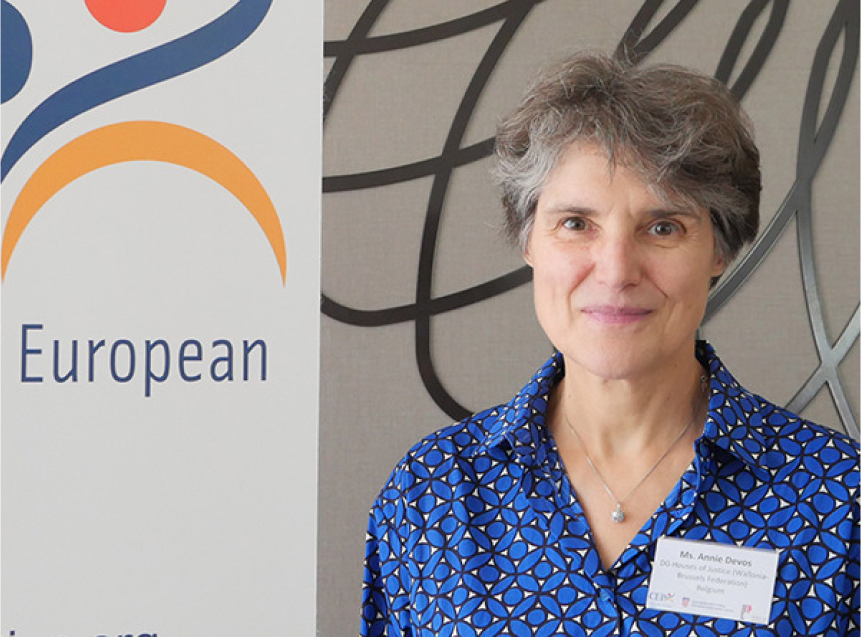13th Electronic Monitoring Conference, Caiscas, Portugal, 2024
From 3-5 December 2024, the town of Cascais in Lisbon, Portugal, became the venue of meaningful dialogue and collaboration at the 13th Electronic Monitoring (EM) Conference. With 259 participants from more than 38 countries, this year’s event, themed “Beyond Control – Electronic Monitoring and Prevention,” provided a platform to discuss the latest developments, challenges, and future opportunities in the field of electronic monitoring.
Speakers

Mr. Rui Abrunhosa Gonçalves
(Director-General of DGRSP)

Ms. Annie Devos
(President of CEP)

Mr. João D’Oliveira Cóias
(Deputy Director of DGRSP)

Ms. Conceição Condeço
(Director of Electronic Monitoring)

Ms. Ana Cristina Neves
(Head of Community Measures Division)

Ms. Louise Forman
(Head of Operations – Probation Service (PS) Wales)

Professor Hans Grönqvist
(Linnaeus University and IFAU, Sweden)

Ms. Susan Niknami
(Stockholm University, Sweden)

Mr. Rait Kuuse
(Deputy Secretary General MoJ Estonia)

Ms. Anais Vacherot
(Deputy Head of EM section France)

Mr. Van Cauwenberghe
(Investigation Judge at rest)

Professor Anthea Hucklesby
(Birmingham Law School and School for Social Policy, University of Birmingham)

Mr. Jorge Monteiro
(Head of programs and Projects Portugal)

Ms. Lucie Ledez
(Probation Director Department Pas-de-Calais, France)

Professor Michele Burman
(Scottish Centre for Crime and Justice Research , University of Glasgow)

Mr. Peter Casteur
(head of department Policy Development at the Flemish agency Opgroeien (Juveniles))

Ms. Christine Andersson
(Swedish Prison and Probation Service)

Ms. Maria Svantesson
(Swedish Prison and Probation Service)

Mr. Diede van der Heijden
(Dutch Youth Protection West)
Read below short abstract about several of the plenary presentations that are included in the conference programme.
- Impacts of Electronic Monitoring
Despite the growth in the use of electronic monitoring (EM) in many countries, research on its impact on wearers and their families is relatively limited. To date quantitative studies have focused on criminal justice impacts (compliance and reoffending) whilst studies drawing attention to other impacts on the lives of wearers have been qualitative and based on relatively small samples. The availability of large databases of monitoring data which can be linked with data from other sources within and outwith criminal justice organisations such as probation and health data provides the opportunity to explore the impacts of EM more wholistically and quantitatively. This session will explore the findings of two studies, one in England and Wales and one in Sweden, which have used these new data sources to explore the criminal justice and wider impacts of EM on wearers.
- Breaches and non-compliance
One of the strengths of EM is that it detects non-compliance events systematically and immediately, bolstering confidence in its ability to manage wearers’ behaviour and providing additional reassurance to court decision-makers. However, it also raises challenges given the number of minor violations detected by EM equipment, the battery charging regimes required by GPS devices and the amount of information generated. This session compares and contrasts the different approaches taken to managing EM violations in several countries, focusing on their breach policies and practices to improve understanding of what is effective. It will distinguish between processes and outcomes of technology-led and people-led approaches to managing non-compliance and breaches. It will also highlight similarities and differences between pre-and post-conviction breach policies, procedures and practices.
- Pre-trial use of electronic monitoring
Many countries use EM (RF and GPS technologies) during the pre-trial stage when wearers are awaiting trial and presumed to be innocent. According to the European Convention of Human Rights, other international conventions and many national laws, the purposes of EM at this stage of the criminal justice process differ from those post-conviction and should not relate to punishment or rehabilitation. EM should be used to meet the concerns of courts set out in relevant legislation, which relate to inter alia public protection and risks of absconding, further offending and interfering with the administration of justice. Despite this, all wearers whether pre- or post-conviction are treated the same in some countries, raising human rights concerns.
EM is used to monitor conditions which facilitate release/bail, for example, house arrest, curfews and exclusion/inclusion zones. In some countries, but not necessarily all, EM is a direct alternative to pre-trial detention. Consequently, one justification for its increasing use across Europe has been as a tool to reduce pre-trial prison populations. It is also viewed as less disruptive, burdensome and uncomfortable for wearers than pre-trial detention.
This session will examine how EM is used at the pre-trial stage, highlighting some best practices and some of the challenges, including how to ensure that pre-trial EM complies with European standards for the treatment of those awaiting trial. Available evidence about its effectiveness in terms of managing prison populations, the risks of absconding and reoffending and ensuring that defendants face trial will also be explored.
The conference was chaired by CEP Secretary General Jana Spero Kamenjarin, who guided discussions, ensuring the exchange of insights and ideas throughout the event.The conference brought together leading experts, practitioners, policymakers, and researchers to exchange knowledge and foster innovation. Over three days, participants explored electronic monitoring not only as a mechanism for compliance but also as a tool for prevention and rehabilitation. The program was designed to balance thought-provoking plenary sessions, interactive workshops, and opportunities for informal networking, creating a vibrant and dynamic experience.
Day 1: Setting the Stage
The first day of the conference set the tone with a series of inspiring welcome speeches. Ms. Carla Semedo, Councillor of Cascais Municipality, and Mr. João D’Oliveira Coias and Mr. Paulo Rio, senior representatives of DGRSP Portugal, emphasized the importance of international collaboration in advancing electronic monitoring practices. Ms. Annie Devos, President of CEP, highlighted the potential of electronic monitoring to address complex societal challenges.
The opening plenary session showcased The Portuguese Approach to Electronic Monitoring, with Mr. João D’Oliveira Cóias and Ms. Conceição Condeço of DGRSP Portugal providing an in-depth overview of their nation’s achievements and ongoing challenges in this field. This was followed by a thought-provoking session on the Impacts of Electronic Monitoring, where Ms. Louise Forman (UK) and Professor Hans Grönqvist (Linnaeus University, Sweden) shared research findings and operational insights from their respective countries.
The afternoon concluded with a lively roundtable discussion on Breaches and Non-Compliance. Speakers Mr. Jako Salla (Estonia), Ms. Anais Vacherot (France), and Ms. Pia Andersson (Finland) delved into practical strategies to address challenges in ensuring compliance with electronic monitoring measures.
Day 2: Deepening the Dialogue
The second day of the conference was dedicated to interactive workshops and focused sessions that delved into key thematic areas. The morning began with workshops addressing the Impacts of EM and Breaches and Non-Compliance, allowing participants to explore these topics in greater detail and share their own experiences and perspectives.
In a plenary session on the Pre-trial Use of Electronic Monitoring, Professor Anthea Hucklesby (UK) and Mr. Karel Van Cauwenberghe (Belgium) examined the role of electronic monitoring in pre-trial settings, presenting research and case studies that illuminated both the opportunities and challenges of this approach.
The afternoon session shifted focus to the critical issue of Domestic Violence and Electronic Monitoring. Mr. Jorge Monteiro (Portugal), Ms. Lucie Ledez (France), and Professor Michele Burman (Scotland) provided compelling insights into how electronic monitoring can be used to protect victims, prevent reoffending, and support systemic change.
Day 3: Focus on Juveniles and Closing Reflections
The final day of the conference featured a series of workshops and plenary sessions that addressed some of the most pressing issues in electronic monitoring. Morning workshops revisited the themes of Pre-trial Use of EM and Domestic Violence and Electronic Monitoring, enabling participants to build on earlier discussions and share actionable insights.
The plenary session on Juveniles and Electronic Monitoring was a highlight of the day. Speakers Mr. Peter Casteur (Belgium), Ms. Christine Andersson and Ms. Maria Svantesson (Sweden), and Mr. Diede van der Heijden (Netherlands) shared innovative approaches to supporting young people through electronic monitoring, emphasizing its potential to foster rehabilitation and prevent future involvement in the justice system.
The conference concluded with reflections on the workshop discussions and closing remarks, which celebrated the shared commitment to advancing electronic monitoring practices across Europe and beyond.
Looking Ahead
The 13th Electronic Monitoring Conference was a resounding success, showcasing the power of collaboration, knowledge-sharing, and innovation. With 259 participants from over 38 countries, the event highlighted the importance of electronic monitoring as a tool for prevention, compliance, and rehabilitation.
We extend our heartfelt gratitude to the speakers, participants, and sponsors who contributed to this event’s success. As we reflect on the progress made, we look forward to continuing these important conversations and welcoming you to future editions of the CEP Electronic Monitoring Conference.
Thank you for joining us on this journey to go beyond control and toward a better future for justice systems worldwide.
Presentations
To view the presentations and workshop results click here.
Pictures
Report
- Domestic violence and electronic monitoring
In response to the widespread and persistent problem of domestic violence, electronic monitoring (EM) has emerged as a potential tool for reducing reoffending and improving victim safety. While EM shows promise further research and evaluation are necessary to fully understand its effectiveness and its legal, ethical and social implications. As we look to the future of domestic violence prevention, the use of EM must be carefully examined and evaluated, with an eye towards maximising its benefits whilst minimising potential harms to wearers, victims’ and their families.
This session examines the potential benefits and limitations of using EM in domestic violence cases, including its impact on victims’ safety and reoffending, its cost-effectiveness as well as legal, ethical and social considerations.
This session explores the challenges and (best) practices related to using EM in domestic violence cases. How can research and practice generate new evidence on the effectiveness of EM in reducing reoffending and improving victim safety? What’s the right balance between offender accountability and respect for individual rights.
- Juveniles and electronic monitoring
In some European countries electronic monitoring is being considered for the first time as a response to emerging trends in juvenile offending, including an increase in gang-related violence and young people’s involvement in drug supply. Its potential use has also arisen because of changes to criminal laws and policies which have resulted in stricter criminal sanctions and measures. In other countries, such as England and Wales, it is already being used with juveniles, and to tackle offending linked to gangs, drugs and weapons. This session will reflect on whether EM should be a tool to control and support juveniles to desist from offending, the implications of using it for this group and how EM practices need to be developed to take account of juveniles’ special status and human rights considerations. The discussion will draw on the experience of countries in different stages of developing EM for use with juveniles.
Workshops
The workshops are an extension of the plenary session. There are 2 rounds of 2 workshops each, for which you are requested to make a choice when completing your registration.
Subscribe to our bi-monthly email newsletter!
"*" indicates required fields
- Keep up to date with important probation developments and insights.

